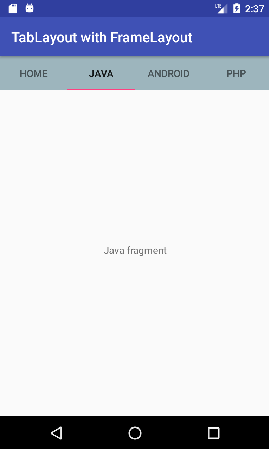Android TabLayout with FrameLayout
在之前的页面中,我们使用TabLayout和ViewPager创建了一个滑动选项卡。在这里,我们将使用TabLayout和FrameLayout创建非滑动选项卡。
TabLayout的项目通过添加Android Support Design Widget的TabItem来实现。
TabLayout使用FrameLayout的示例
让我们创建一个使用FrameLayout和Fragment的TabLayout示例。
文件:activity.xml
创建一个包含TabLayout和FrameLayout视图组件的activity.xml文件。
<?xml version="1.0" encoding="utf-8"?>
<android.support.constraint.ConstraintLayout xmlns:android="http://schemas.android.com/apk/res/android"
xmlns:app="http://schemas.android.com/apk/res-auto"
xmlns:tools="http://schemas.android.com/tools"
android:layout_width="match_parent"
android:layout_height="match_parent"
tools:context="tablayout.example.com.tablayoutwithframelayout.MainActivity">
<android.support.design.widget.TabLayout
android:id="@+id/tabLayout"
android:layout_width="match_parent"
android:layout_height="wrap_content"
android:background="#7367">
<android.support.design.widget.TabItem
android:layout_width="wrap_content"
android:layout_height="wrap_content"
android:text="Home" />
<android.support.design.widget.TabItem
android:layout_width="wrap_content"
android:layout_height="wrap_content"
android:text="Java" />
<android.support.design.widget.TabItem
android:layout_width="wrap_content"
android:layout_height="wrap_content"
android:text="Android" />
<android.support.design.widget.TabItem
android:layout_width="wrap_content"
android:layout_height="wrap_content"
android:text="Php" />
</android.support.design.widget.TabLayout>
<FrameLayout
android:id="@+id/frameLayout"
android:layout_width="match_parent"
android:layout_height="455dp"
app:layout_constraintEnd_toEndOf="parent"
app:layout_constraintStart_toStartOf="parent"
app:layout_constraintTop_toBottomOf="@+id/tabLayout">
</FrameLayout>
</android.support.constraint.ConstraintLayout>
文件:build.gradle
现在在build.gradle文件中添加了TabLayout的依赖库。
implementation 'com.android.support:design:26.1.0'
文件:MainActivity.java
package tablayout.example.com.tablayoutwithframelayout;
import android.support.design.widget.TabLayout;
import android.support.v4.app.Fragment;
import android.support.v4.app.FragmentManager;
import android.support.v4.app.FragmentTransaction;
import android.support.v7.app.AppCompatActivity;
import android.os.Bundle;
import android.widget.FrameLayout;
public class MainActivity extends AppCompatActivity {
TabLayout tabLayout;
FrameLayout frameLayout;
Fragment fragment = null;
FragmentManager fragmentManager;
FragmentTransaction fragmentTransaction;
@Override
protected void onCreate(Bundle savedInstanceState) {
super.onCreate(savedInstanceState);
setContentView(R.layout.activity_main);
tabLayout=(TabLayout)findViewById(R.id.tabLayout);
frameLayout=(FrameLayout)findViewById(R.id.frameLayout);
fragment = new HomeFragment();
fragmentManager = getSupportFragmentManager();
fragmentTransaction = fragmentManager.beginTransaction();
fragmentTransaction.replace(R.id.frameLayout, fragment);
fragmentTransaction.setTransition(FragmentTransaction.TRANSIT_FRAGMENT_OPEN);
fragmentTransaction.commit();
tabLayout.addOnTabSelectedListener(new TabLayout.OnTabSelectedListener() {
@Override
public void onTabSelected(TabLayout.Tab tab) {
// Fragment fragment = null;
switch (tab.getPosition()) {
case 0:
fragment = new HomeFragment();
break;
case 1:
fragment = new JavaFragment();
break;
case 2:
fragment = new AndroidFragment();
break;
case 3:
fragment = new PhpFragment();
break;
}
FragmentManager fm = getSupportFragmentManager();
FragmentTransaction ft = fm.beginTransaction();
ft.replace(R.id.frameLayout, fragment);
ft.setTransition(FragmentTransaction.TRANSIT_FRAGMENT_OPEN);
ft.commit();
}
@Override
public void onTabUnselected(TabLayout.Tab tab) {
}
@Override
public void onTabReselected(TabLayout.Tab tab) {
}
});
}
}
现在为所有不同的选项卡创建不同的片段文件。
文件:HomeFragment.java
package tablayout.example.com.tablayoutwithframelayout;
import android.os.Bundle;
import android.support.v4.app.Fragment;
import android.view.LayoutInflater;
import android.view.View;
import android.view.ViewGroup;
public class HomeFragment extends Fragment {
public HomeFragment() {
// Required empty public constructor
}
@Override
public View onCreateView(LayoutInflater inflater, ViewGroup container,
Bundle savedInstanceState) {
// Inflate the layout for this fragment
return inflater.inflate(R.layout.fragment_home, container, false);
}
}
文件:fragment_home.xml
<FrameLayout xmlns:android="http://schemas.android.com/apk/res/android"
xmlns:tools="http://schemas.android.com/tools"
android:layout_width="match_parent"
android:layout_height="match_parent"
tools:context="tablayout.example.com.tablayoutwithframelayout.HomeFragment">
<!-- TODO: Update blank fragment layout -->
<TextView
android:layout_width="match_parent"
android:layout_height="match_parent"
android:gravity="center"
android:text="@string/home_fragment" />
</FrameLayout>
文件: JavaFragment.java
package tablayout.example.com.tablayoutwithframelayout;
import android.os.Bundle;
import android.support.v4.app.Fragment;
import android.view.LayoutInflater;
import android.view.View;
import android.view.ViewGroup;
public class JavaFragment extends Fragment {
public JavaFragment() {
// Required empty public constructor
}
@Override
public View onCreateView(LayoutInflater inflater, ViewGroup container,
Bundle savedInstanceState) {
// Inflate the layout for this fragment
return inflater.inflate(R.layout.fragment_java, container, false);
}
}
文件: fragment_java.xml
<FrameLayout xmlns:android="http://schemas.android.com/apk/res/android"
xmlns:tools="http://schemas.android.com/tools"
android:layout_width="match_parent"
android:layout_height="match_parent"
tools:context="tablayout.example.com.tablayoutwithframelayout.JavaFragment">
<!-- TODO: Update blank fragment layout -->
<TextView
android:layout_width="match_parent"
android:layout_height="match_parent"
android:gravity="center"
android:text="@string/java_fragment" />
</FrameLayout>
文件: AndroidFragment.java
package tablayout.example.com.tablayoutwithframelayout;
import android.os.Bundle;
import android.support.v4.app.Fragment;
import android.view.LayoutInflater;
import android.view.View;
import android.view.ViewGroup;
public class AndroidFragment extends Fragment {
public AndroidFragment() {
// Required empty public constructor
}
@Override
public View onCreateView(LayoutInflater inflater, ViewGroup container,
Bundle savedInstanceState) {
// Inflate the layout for this fragment
return inflater.inflate(R.layout.fragment_android, container, false);
}
}
文件: fragment_android.xml
<FrameLayout xmlns:android="http://schemas.android.com/apk/res/android"
xmlns:tools="http://schemas.android.com/tools"
android:layout_width="match_parent"
android:layout_height="match_parent"
tools:context="tablayout.example.com.tablayoutwithframelayout.AndroidFragment">
<!-- TODO: Update blank fragment layout -->
<TextView
android:layout_width="match_parent"
android:layout_height="match_parent"
android:gravity="center"
android:text="@string/android_fragment" />
</FrameLayout>
文件: PhpFragment.java
package tablayout.example.com.tablayoutwithframelayout;
import android.os.Bundle;
import android.support.v4.app.Fragment;
import android.view.LayoutInflater;
import android.view.View;
import android.view.ViewGroup;
public class PhpFragment extends Fragment {
public PhpFragment() {
// Required empty public constructor
}
@Override
public View onCreateView(LayoutInflater inflater, ViewGroup container,
Bundle savedInstanceState) {
// Inflate the layout for this fragment
return inflater.inflate(R.layout.fragment_php, container, false);
}
}
文件:fragment_php.xml
<FrameLayout xmlns:android="http://schemas.android.com/apk/res/android"
xmlns:tools="http://schemas.android.com/tools"
android:layout_width="match_parent"
android:layout_height="match_parent"
tools:context="tablayout.example.com.tablayoutwithframelayout.PhpFragment">
<!-- TODO: Update blank fragment layout -->
<TextView
android:layout_width="match_parent"
android:layout_height="match_parent"
android:gravity="center"
android:text="@string/php_fragment" />
</FrameLayout>
文件:strings.xml
<resources>
<string name="app_name">TabLayout with FrameLayout</string>
<!-- TODO: Remove or change this placeholder text -->
<string name="home_fragment">Home fragment</string>
<string name="java_fragment">Java fragment</string>
<string name="android_fragment">Android fragment</string>
<string name="php_fragment">Php fragment</string>
</resources>
输出

 极客笔记
极客笔记